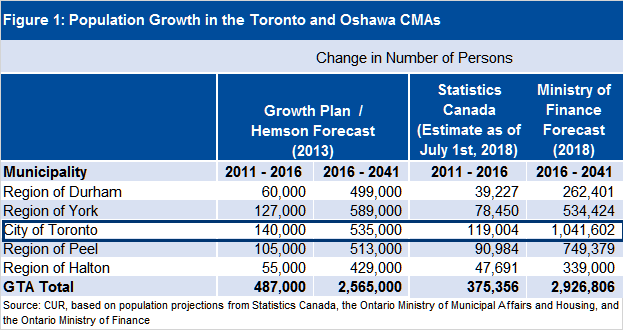Time to Revisit the Population Forecast Underlying the Growth Plan for the Greater Golden Horseshoe
By: Diana Petramala and Alex Beheshti
September 9, 2019
The Growth Plan for the Greater Golden Horseshoe (“the Growth Plan”) was built on a set of population and employment forecasts produced by Hemson Consulting in 2013,1 which used the 2011 Census of Canada as the base year.2 These now outdated forecasts were included in the recently released 2019 update to the Growth Plan.
In contrast, the Ontario Ministry of Finance releases updated population forecasts for the province and its census divisions annually.3 The latest projections, released in June of 2018, show that the forecasts underlying the Growth Plan are now out of date.
Looking Back, the Hemson Forecasts Over-predicted Population Growth Between 2011 and 2016
· Overall, the population in the Greater Toronto Area grew by 112,000 less people between 2011 and 2016 than was expected in the Growth Plan.
· The biggest discrepancies were in the Regions of Durham and York, where population growth was lower than expected by 34% and 38%, respectively.
· Population growth was also lower than expected in the City of Toronto, the Region of Peel and the Halton Region, by 13% to 15%.
The Ministry of Finance Is Predicting Much Larger Population Growth Than Expected in the Growth Plan over the Next 25 years (2016 to 2041)
· The Ministry of Finance projects the GTA will grow by roughly 2.9 million people between 2016 and 2041, almost 360,000 more people than the forecasts underlying the Growth Plan.
· Most of the additional population growth is expected to occur in the City of Toronto. The Ministry of Finance projects the population in the City of Toronto will grow by over 1 million people between 2016 and 2041, double the 2013 estimates of 535,000 people in the Growth Plan.
· The Ministry of Finance also expects the Region of Peel to grow by almost 270,000 more people between 2016 and 2041 than was forecast by Hemson in 2013.
· In contrast, Durham and York Regions are forecast to grow by less than was forecast in 2013.
Bottom Line
A change in immigration policy by the Canadian federal government largely accounts for the difference in population forecasts between the numbers published by the Ministry of Finance in the spring of 2018 and those produced by Hemson in 2013. While Canada received roughly 260,000 immigrants in 2013, the Federal Government is gradually raising immigration targets to 350,000 people per year by 20214 – many of whom are likely to be attracted to the Toronto Census Metropolitan Area (CMA). The Toronto CMA attracted 35% of Canada’s immigration between July 2017 and July 2018, while 90% of that immigration headed for the City of Toronto.
Forecasting is a difficult task, and many factors can render a forecast out of date, such as changes in immigration policy. For this reason, it is important to keep forecasts flexible and regularly updated. The forecasts underlying the Growth Plan should be updated to reflect the change in national immigration trends, thus allowing for better planning decisions to accommodate this growth.

_____________________________________________________________________
Sources:
[1] Hemson Consulting (2012). “Greater Golden Horseshoe Growth Forecasts to 2041”. [Online] Available: (PDF file) https://hemson.com/wp-content/uploads/2016/03/HEMSON-Greater-Golden-Horseshoe-Growth-Forecasts-to-2041-Technical-Report-Nov2012.pdf (external link)
[2] Ministry of Municipal Affairs and Housing (2019) “A Place to Grow: Growth Plan for the Greater Golden Horseshoe”. Population forecasts found in Schedule 3, 93. [Online] Available: https://www.ontario.ca/document/place-grow-growth-plan-greater-golden-horseshoe (external link)
[3] Ministry of Finance (2018). “Ontario Populations Projections Update, June 2018”. [Online] Available: https://www.fin.gov.on.ca/en/economy/demographics/projections/ (external link)
(PDF file) (external link) [4] Immigration.ca (2019). “How many immigrants come to Canada each year?” [Online] Available: https://www.immigration.ca/how-many-immigrants-come-to-canada-each-year (external link)
Diana Petramala is Senior Researcher at Toronto Metropolitan University's Centre for Urban Research and Land Development (CUR) in Toronto.
Alex Beheshti is Research Assistant at Toronto Metropolitan University's Centre for Urban Research and Land Development (CUR) in Toronto.
_________________________________________________________________________________________________________